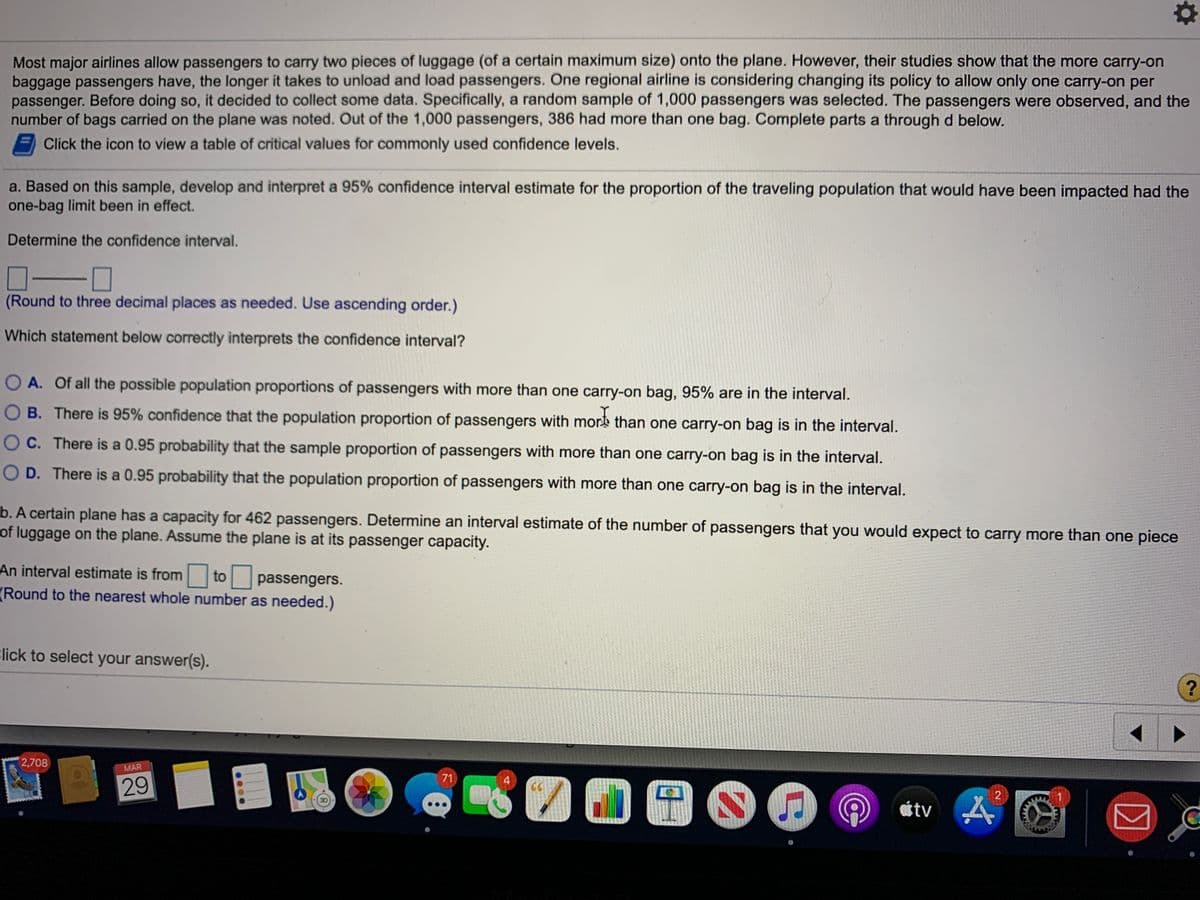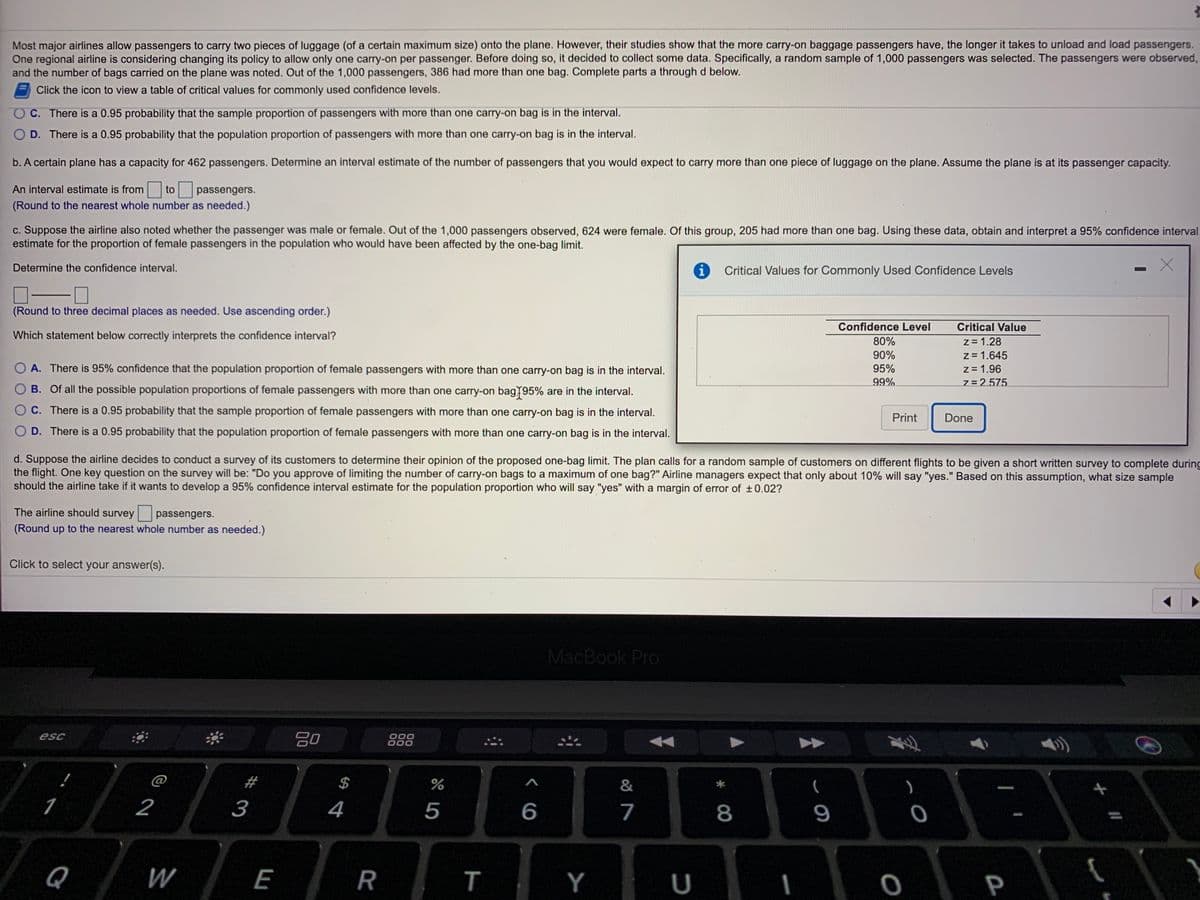Most major airlines allow passengers to carry two pieces of luggage (of a certain maximum size) onto the plane. However, their studies show that the more carry-on baggage passengers have, the longer it takes to unload and load passengers. One regional airline is considering changing its policy to allow only one carry-on per passenger. Before doing so, it decided to collect some data. Specifically, a random sample of 1,000 passengers was selected. The passengers were observed, and the number of bags carried on the plane was noted. Out of the 1,000 passengers, 386 had more than one bag. Complete parts a through d below. Click the icon to view a table of critical values for commonly used confidence levels. a. Based on this sample, develop and interpret a 95% confidence interval estimate for the proportion of the traveling population that would have been impacted had the one-bag limit been in effect. Determine the confidence interval. (Round to three decimal places as needed. Use ascending order.) Which statement below correctly interprets the confidence interval? O A. Of all the possible population proportions of passengers with more than one carry-on bag, 95% are in the interval. OB. There is 95% confidence that the population proportion of passengers with morb than one carry-on bag is in the interval. O C. There is a 0.95 probability that the sample proportion of passengers with more than one carry-on bag is in the interval. O D. There is a 0.95 probability that the population proportion of passengers with more than one carry-on bag is in the interval. b. A certain plane has a capacity for 462 passengers. Determine an interval estimate of the number of passengers that you would expect to carry more than one piece of luggage on the plane. Assume the plane is at its passenger capacity. An interval estimate is from Round to the nearest whole number as needed.) to passengers.
Most major airlines allow passengers to carry two pieces of luggage (of a certain maximum size) onto the plane. However, their studies show that the more carry-on baggage passengers have, the longer it takes to unload and load passengers. One regional airline is considering changing its policy to allow only one carry-on per passenger. Before doing so, it decided to collect some data. Specifically, a random sample of 1,000 passengers was selected. The passengers were observed, and the number of bags carried on the plane was noted. Out of the 1,000 passengers, 386 had more than one bag. Complete parts a through d below. Click the icon to view a table of critical values for commonly used confidence levels. a. Based on this sample, develop and interpret a 95% confidence interval estimate for the proportion of the traveling population that would have been impacted had the one-bag limit been in effect. Determine the confidence interval. (Round to three decimal places as needed. Use ascending order.) Which statement below correctly interprets the confidence interval? O A. Of all the possible population proportions of passengers with more than one carry-on bag, 95% are in the interval. OB. There is 95% confidence that the population proportion of passengers with morb than one carry-on bag is in the interval. O C. There is a 0.95 probability that the sample proportion of passengers with more than one carry-on bag is in the interval. O D. There is a 0.95 probability that the population proportion of passengers with more than one carry-on bag is in the interval. b. A certain plane has a capacity for 462 passengers. Determine an interval estimate of the number of passengers that you would expect to carry more than one piece of luggage on the plane. Assume the plane is at its passenger capacity. An interval estimate is from Round to the nearest whole number as needed.) to passengers.
Holt Mcdougal Larson Pre-algebra: Student Edition 2012
1st Edition
ISBN:9780547587776
Author:HOLT MCDOUGAL
Publisher:HOLT MCDOUGAL
Chapter11: Data Analysis And Probability
Section: Chapter Questions
Problem 8CR
Related questions
Question

Transcribed Image Text:Most major airlines allow passengers to carry two pieces of luggage (of a certain maximum size) onto the plane. However, their studies show that the more carry-on
baggage passengers have, the longer it takes to unload and load passengers. One regional airline is considering changing its policy to allow only one carry-on per
passenger. Before doing so, it decided to collect some data. Specifically, a random sample of 1,000 passengers was selected. The passengers were observed, and the
number of bags carried on the plane was noted. Out of the 1,000 passengers, 386 had more than one bag. Complete parts a through d below.
Click the icon to view a table of critical values for commonly used confidence levels.
a. Based on this sample, develop and interpret a 95% confidence interval estimate for the proportion of the traveling population that would have been impacted had the
one-bag limit been in effect.
Determine the confidence interval.
(Round to three decimal places as needed. Use ascending order.)
Which statement below correctly interprets the confidence interval?
O A. Of all the possible population proportions of passengers with more than one carry-on bag, 95% are in the interval.
O B. There is 95% confidence that the population proportion of passengers with mor than one carry-on bag is in the interval.
O C. There is a 0.95 probability that the sample proportion of passengers with more than one carry-on bag is in the interval.
O D. There is a 0.95 probability that the population proportion of passengers with more than one carry-on bag is in the interval.
b. A certain plane has a capacity for 462 passengers. Determine an interval estimate of the number of passengers that you would expect to carry more than one piece
of luggage on the plane. Assume the plane is at its passenger capacity.
An interval estimate is from to
passengers.
(Round to the nearest whole number as needed.)
Elick to select your answer(s).
2,708
MAR
200
71
4
29
étv 4
2.
...

Transcribed Image Text:Most major airlines allow passengers to carry two pieces of luggage (of a certain maximum size) onto the plane. However, their studies show that the more carry-on baggage passengers have, the longer it takes to unload and load passengers.
One regional airline is considering changing its policy to allow only one carry-on per passenger. Before doing so, it decided to collect some data. Specifically, a random sample of 1,000 passengers was selected. The passengers were observed,
and the number of bags carried on the plane was noted. Out of the 1,000 passengers, 386 had more than one bag. Complete parts a through d below.
Click the icon to view a table of critical values for commonly used confidence levels.
OC. There is a 0.95 probability that the sample proportion of passengers with more than one carry-on bag is in the interval.
O D. There is a 0.95 probability that the population proportion of passengers with more than one carry-on bag is in the interval.
b. A certain plane has a capacity for 462 passengers. Determine an interval estimate of the number of passengers that you would expect to carry more than one piece of luggage on the plane. Assume the plane is at its passenger capacity.
An interval estimate is from to passengers.
(Round to the nearest whole number as needed.)
c. Suppose the airline also noted whether the passenger was male or female. Out of the 1,000 passengers observed, 624 were female. Of this group, 205 had more than one bag. Using these data, obtain and interpret a 95% confidence interval
estimate for the proportion of female passengers in the population who would have been affected by the one-bag limit.
Critical Values for Commonly Used Confidence Levels
Determine the confidence interval.
(Round to three decimal places as needed. Use ascending order.)
Critical Value
Confidence Level
z = 1.28
z= 1.645
z= 1.96
80%
Which statement below correctly interprets the confidence interval?
90%
95%
O A. There is 95% confidence that the population proportion of female passengers with more than one carry-on bag is in the interval.
99%
7= 2.575
B. Of all the possible population proportions of female passengers with more than one carry-on bag195% are in the interval.
Print
Done
C. There is a 0.95 probability that the sample proportion of female passengers with more than one carry-on bag is in the interval.
D. There is a 0.95 probability that the population proportion of female passengers with more than one carry-on bag is in the interval.
d. Suppose the airline decides to conduct a survey of its customers to determine their opinion of the proposed one-bag limit. The plan calls for a random sample of customers on different flights to be given a short written survey to complete during
the flight. One key question on the survey will be: "Do you approve of limiting the number of carry-on bags to a maximum of one bag?" Airline managers expect that only about 10% will say "yes." Based on this assumption, what size sample
should the airline take if it wants to develop a 95% confidence interval estimate for the population proportion who will say "yes" with a margin of error of ±0.02?
The airline should survey
passengers.
(Round up to the nearest whole number as needed.)
Click to select your answer(s).
MacBook Pro
000
000
esc
@
#
&
1
2
3
4
5
6
7
8
9
Q
W
E
Y
P
R
%24
Expert Solution
This question has been solved!
Explore an expertly crafted, step-by-step solution for a thorough understanding of key concepts.
This is a popular solution!
Trending now
This is a popular solution!
Step by step
Solved in 4 steps

Knowledge Booster
Learn more about
Need a deep-dive on the concept behind this application? Look no further. Learn more about this topic, statistics and related others by exploring similar questions and additional content below.Recommended textbooks for you

Holt Mcdougal Larson Pre-algebra: Student Edition…
Algebra
ISBN:
9780547587776
Author:
HOLT MCDOUGAL
Publisher:
HOLT MCDOUGAL

Holt Mcdougal Larson Pre-algebra: Student Edition…
Algebra
ISBN:
9780547587776
Author:
HOLT MCDOUGAL
Publisher:
HOLT MCDOUGAL